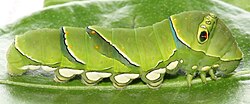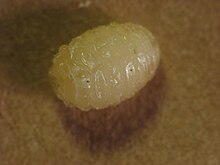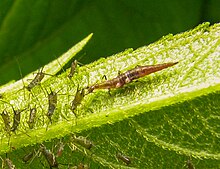Larva

Alarva(/ˈlɑːrvə/;pl.:larvae/ˈlɑːrviː/) is a distinct juvenile form manyanimalsundergo beforemetamorphosisinto their next life stage. Animals with indirectdevelopmentsuch asinsects,somearachnids,amphibians,orcnidarianstypically have a larval phase of theirlife cycle.
A larva's appearance is generally very different from the adult form (e.g.caterpillarsandbutterflies) including different unique structures and organs that do not occur in the adult form. Their diet may also be considerably different. In the case of smaller primitive arachnids, the larval stage differs by having three instead of four pairs of legs.[1]
Larvae are frequently adapted to different environments than adults. For example, some larvae such astadpoleslive almost exclusively in aquatic environments, but can live outside water as adultfrogs.By living in a distinct environment, larvae may be given shelter from predators and reduce competition for resources with the adult population.
Animals in the larval stage will consume food to fuel their transition into the adult form. In some organisms likepolychaetesandbarnacles,adults are immobile but their larvae are mobile, and use their mobile larval form to distribute themselves.[2][3]These larvae used for dispersal are eitherplanktotrophic (feeding) or lecithotrophic (non-feeding).
Some larvae are dependent on adults to feed them. In many eusocialHymenopteraspecies, the larvae are fed by female workers. InRopalidia marginata(a paper wasp) the males are also capable of feeding larvae but they are much less efficient, spending more time and getting less food to the larvae.[4]
The larvae of some organisms (for example, somenewts) can becomepubescentand do not develop further into the adult form. This is a type ofneoteny.[5]

It is a misunderstanding that the larval form alwaysreflects the group's evolutionary history.This could be the case, but often the larval stage has evolved secondarily, as in insects.[6][7]In these cases[clarification needed],the larval form may differ more than the adult form from the group's common origins.[8]
Selected types of larvae
[edit]Insect larvae
[edit]

WithinInsects,onlyEndopterygotesshow complete metamorphosis, including a distinct larval stage.[10][11]Several classifications have been suggested by manyentomologists,[12][13]and following classification is based onAntonio Berleseclassification in 1913. There are four main types of endopterygote larvae types:[14][15]
- Apodous larvae– no legs at all and are poorly sclerotized. Based onsclerotization.All Apocrita are apodous. Threeapodousforms are recognized.
- Eucephalous – with well sclerotized head capsule. Found inNematocera,BuprestidaeandCerambycidaefamilies.
- Hemicephalus – with a reduced head capsule, retractable in to the thorax. Found inTipulidaeandBrachycerafamilies.
- Acephalus – without head capsule. Found inCyclorrhapha
- Protopod larvae– larva have many different forms and often unlike a normal insect form. They hatch from eggs which contain very littleyolk.E.g. firstinstarlarvae of parasitic hymenoptera.
- Polypod larvae– also known aseruciform larvae,these larvae have abdominal prolegs, in addition to usual thoracic legs. They are poorly sclerotized and relatively inactive. They live in close contact with their food. Best example iscaterpillarsof lepidopterans.
- Oligopod larvae– have well developed head capsule and mouthparts are similar to the adult, but without compound eyes. They have six legs. No abdominal prolegs. Two types can be seen:
- Campodeiform – well sclerotized, dorso-ventrally flattened body. Usually long legged predators withprognathousmouthparts. (lacewing, trichopterans, mayflies and some coleopterans).
- Scarabeiform – poorly sclerotized, flat thorax and abdomen. Usually short legged and inactive burrowing forms. (Scarabaeoideaand other coleopterans).
See also
[edit]- Crustacean larvae
- Ichthyoplankton
- Maggots
- Spawn (biology)
- Non-larval animaljuvenile(immature) stages and otherlife cyclestages:
- InPorifera:olynthus,gemmule
- InCnidaria:ephyra,scyphistoma,strobila,gonangium,hydranth,polyp,medusa
- InMollusca:paralarva,youngcephalopods
- InPlatyhelminthes:hydatid cyst
- InBryozoa:avicularium
- InAcanthocephala:cystacanth
- InInsecta:
- Nymphs and naiads,immature forms inhemimetabolousinsects
- Subimago,a juvenile that resembles the adult inEphemeroptera
- Instar,intermediate between eachecdysis
- Pupaandchrysalis,intermediate stages between larva andimago(the adult stage)
- Protozoan life cycle stages
- Algal life cycle stages:
- Codiolum-phase
- Conchocelis-phase
- Marine larval ecology
References
[edit]- ^"TICK IDENTIFICATION".Division of environmental health.4 October 2024.
- ^Qian, Pei-Yuan (1999), "Larval settlement of polychaetes",Reproductive Strategies and Developmental Patterns in Annelids,Dordrecht: Springer Netherlands, pp. 239–253,doi:10.1007/978-94-017-2887-4_14,ISBN978-90-481-5340-4
- ^Chen, Zhang-Fan; Zhang, Huoming; Wang, Hao; Matsumura, Kiyotaka; Wong, Yue Him; Ravasi, Timothy; Qian, Pei-Yuan (2014-02-13)."Quantitative Proteomics Study of Larval Settlement in the Barnacle Balanus amphitrite".PLOS ONE.9(2): e88744.Bibcode:2014PLoSO...988744C.doi:10.1371/journal.pone.0088744.ISSN1932-6203.PMC3923807.PMID24551147.
- ^Sen, R; Gadagkar, R (2006). "Males of the social wasp Ropalidia marginata can feed larvae, given an opportunity".Animal Behaviour.71(2): 345–350.doi:10.1016/j.anbehav.2005.04.022.S2CID39848913.
- ^Wakahara, Masami (1996). "Heterochrony and Neotenic Salamanders: Possible Clues for Understanding the Animal Development and Evolution".Zoological Science.13(6): 765–776.doi:10.2108/zsj.13.765(inactive 2024-04-10).ISSN0289-0003.PMID9107136.S2CID35101681.
{{cite journal}}:CS1 maint: DOI inactive as of April 2024 (link) - ^Nagy, Lisa M.; Grbić, Miodrag (1999), "Cell Lineages in Larval Development and Evolutions of Holometabolous Insects",The Origin and Evolution of Larval Forms,Elsevier, pp. 275–300,doi:10.1016/b978-012730935-4/50010-9,ISBN978-0-12-730935-4
- ^Raff, Rudolf A (2008-01-11)."Origins of the other metazoan body plans: the evolution of larval forms".Philosophical Transactions of the Royal Society B: Biological Sciences.363(1496): 1473–1479.doi:10.1098/rstb.2007.2237.ISSN0962-8436.PMC2614227.PMID18192188.
- ^Williamson, Donald I.(2006)."Hybridization in the evolution of animal form and life-cycle".Zoological Journal of the Linnean Society.148(4): 585–602.doi:10.1111/j.1096-3642.2006.00236.x.
- ^Moore, R.C. (1959).Arthropoda I – Arthropoda General Features, Proarthropoda, Euarthropoda General Features, Trilobitomorpha.Treatise on Invertebrate Paleontology.Vol. Part O. Boulder, Colorado/Lawrence, Kansas: Geological Society of America/University of Kansas Press. pp. O121, O122, O125.ISBN978-0-8137-3015-8.
- ^"Division: Endopterygota – Amateur Entomologists' Society (AES)".www.amentsoc.org.Retrieved2020-08-03.
- ^"Recognizing Insect Larval Types".University of Kentucky.Retrieved28 April2016.
- ^JOHNSON, NORMAN. TRIPLEHORN, CHARLES A. (2020).BORROR AND DELONG'S INTRODUCTION TO THE STUDY OF INSECTS.CENGAGE LEARNING CUSTOM P.ISBN978-0-357-67127-6.OCLC1163940863.
{{cite book}}:CS1 maint: multiple names: authors list (link) - ^Capinera, John L., ed. (2008).Encyclopedia of Entomology.Dordrecht: Springer Netherlands.doi:10.1007/978-1-4020-6359-6.ISBN978-1-4020-6242-1.
- ^"Types of Insect Larva".Agri info. Archived fromthe originalon 14 May 2016.Retrieved28 April2016.
- ^"Types of Insect Larva".agriinfo.in.2017-03-23. Archived fromthe originalon 2017-02-04.Retrieved2021-11-22.
Bibliography
[edit]- Brusca, R. C. & Brusca, G. J. (2003).Invertebrates(2nd ed.). Sunderland, Mass.: Sinauer Associates.
- Hall, B. K. & Wake, M. H., eds. (1999).The Origin and Evolution of Larval Forms.San Diego: Academic Press.
- Leis, J. M. & Carson-Ewart, B. M., eds. (2000). The Larvae of Indo-Pacific Coastal Fishes. An Identification Guide to Marine Fish Larvae.Fauna Malesiana handbooks, vol. 2. Brill, Leiden.
- Minelli, A. (2009). The larva. In:Perspectives in Animal Phylogeny and Evolution.Oxford University Press. p. 160–170.link.
- Shanks, A. L. (2001).An Identification Guide to the Larval Marine Invertebrates of the Pacific Northwest.Oregon State University Press, Corvallis. 256 pp.
- Smith, D. & Johnson, K. B. (1977).A Guide to Marine Coastal Plankton and Marine Invertebrate Larvae.Kendall/Hunt Plublishing Company.
- Stanwell-Smith, D., Hood, A. & Peck, L. S. (1997).A field guide to the pelagic invertebrates larvae of the maritime Antarctic.British Antarctic Survey, Cambridge.
- Thyssen, P.J. (2010).Keys for Identification of Immature InsectsArchived2017-08-09 at theWayback Machine.In: Amendt, J. et al. (ed.).Current Concepts in Forensic Entomology,chapter 2, pp. 25–42. Springer: Dordrecht.
